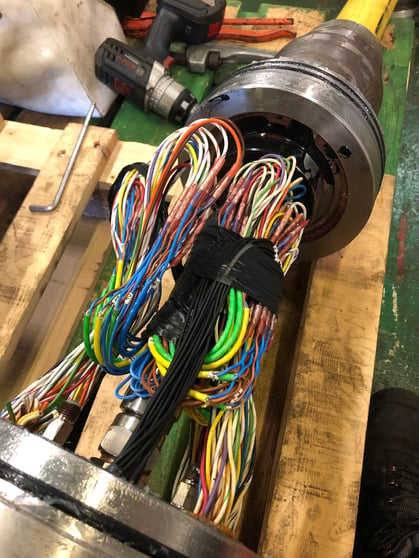DeRegt Cables field service engineers have decades of experience repairing and maintaining critical marine cables used for seismic data acquisition and other subsea activities. In Part I, we highlighted sustainable cable re-termination methods practiced by DeRegt Field Service engineers.
In Part II, we discuss the ways that marine cable operations can save time and money while improving the sustainability of their operations.

3 benefits of recycling materials
Reducing the environmental impact of subsea operations by recycling and reusing termination materials where possible is important for sustainable development. And like many sustainability efforts, it provides additional benefits to the company, in the form of shorter downtimes and lower costs.
1. Shorter Delivery Times
When it comes to cable repairs at sea, time is of the essence because each day of operations comes at an enormous price tag.
“Reusing parts is usually faster and saves time by avoiding supply chain interruptions,” said Mario Boot, head of the Field Service Division at DeRegt. “Getting hold of steel is already a problem these days, so by reusing a part, you won’t have the long lead times for manufacturing new parts.”
To ensure the fastest possible cable termination service, DeRegt maintains a store of both new and refurbished off-the-shelf and custom parts for each of its clients, ready to go at a moment’s notice.
2. Lower Repair Costs
Refurbished and reused components can save significantly on the cost of re-terminations. Whenever possible, our field service engineers save clients’ money by carefully cleaning and refurbishing used components back at the factory and then reusing them the next time out.
“The bellhouse, the armor body, the faceplate – all the steel components of a termination can be designed to be reused,” Boot said. “There are also components that can’t be replaced properly. For example, not all connectors can’t be replaced individually. In reality, our clients expect us to replace those connectors as well.”
Example: Saving money with sustainable design
As an example, a new faceplate could cost about 2,100 euros and each of the connectors might cost about 1,200 euros. With eight connectors installed on a typical faceplate designed with conical threading, even if just one connector is damaged, the faceplate and all eight connectors would have to be replaced at a cost of almost 12,000 euros.
In contrast, DeRegt can design a faceplate that accepts connectors with straight threads held by a nut, so removing a connector won’t damage the entire faceplate. Then, if a single connector does get damaged, it can be taken out and replaced individually without having to purchase an entirely new faceplate assembly.
“This solution would cost only about 1,200 euros, compared with ten times that amount for the conical threaded design,” said Boot. “And you can always fit a straight connector into another termination, so those connectors also can be reused.”
3. Environmental Benefits
More and more, sustainability has become the responsibility of every business, and reusing parts in cable terminations is just one way that seismic and other marine operations contribute to a cleaner environment. By avoiding the creation of new steel components, you avoid the harm caused by mining of coal and other raw materials, as well as the significant amount of CO2 released when generating electricity to produce the steel.
We recognize that not all the materials left over from a re-termination can be reused. Broken steel parts can always be recycled, which is still less harmful to the environment. Meanwhile, at DeRegt Field Service, we make a practice of responsibly bagging and disposing of all non-recyclable components, such as the sheathing cut from wires, before it washes off the deck and into the sea – adding to the burden of plastic pollution.
Following that same philosophy, it is also very important that chemicals are processed according to manufacturer's instructions. For example, the potting material used to form the chemical seal in the re-termination can be harmful to the environment in its liquid state. This material consists of two chemical components that come in a divided plastic pouch. To use it, you open the seal between the two compartments, mix them, and let it cure.
“As soon as the product is cured, there’s no more hazard,” Boot said, “but you still have to dispose it by certain rules. As long as it remains liquid, you have to be careful with it.” When a packet of the compound passes its expiration date, he advises mixing the components and letting it harden before throwing it out.
By following these practices, DeRegt leads the way to more sustainable and profitable subsea cable operations for our clients.
.jpg?width=429&height=572&name=ontzorgen%20(1).jpg)
For a more sustainable and affordable cable operation, contact DeRegt
Our expert and experienced undersea cable Field Services Division is on call 24-7 to help reduce or eliminate downtime for your subsea cables. We are committed to treating the environment responsibly on land and at sea by recycling and reusing materials whenever possible.
Download this case study on our strategic partnership between DeRegt and PGS, showing how our Field Services Division has helped to sustainably maintain that company’s marine cable seismic data acquisition cables for maximum production while at sea.



